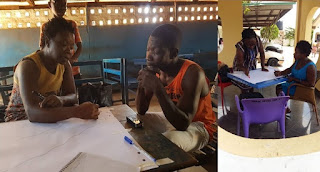By Emmanuel Quarshie
In Ghana we have been researching the interplay of gender, generation and migration using a participatory approach to data collection and analysis - the River of Life. This blog summarizes how the method is used to gather data and its relevance to the broader context of qualitative research. Also, it highlights the challenges faced in using the method and how they were resolved with recommendations for future studies.
In Ghana we have been researching the interplay of gender, generation and migration using a participatory approach to data collection and analysis - the River of Life. This blog summarizes how the method is used to gather data and its relevance to the broader context of qualitative research. Also, it highlights the challenges faced in using the method and how they were resolved with recommendations for future studies.
The River of life is a qualitative data collection tool
that allows participants to reflect on their personal experiences, highlighting
the factors that have (de)motivated them in their personal and professional
lives. Originally designed to serve as an ice breaker, it provides participants
in workshops and seminars the opportunity to quickly
introduce themselves to one another and start to build a rapport with the
group.
The River of Life method is also used by
non-governmental organizations and other development agencies in their
activities. It helps provide development workers with an insight into the lives
of the various residents in the communities in which they work. For the purpose
of the Gender and Generation study, both adults (male and female) and youth
(male and female) participated in this method.
Relevance of the River of Life method in qualitative research
The method is a visualization of the life stories of the participants. By
drawing the obstacles and opportunities that have influenced the flow of their
lives, the method helps participants
and researchers elaborate complex narratives with
many twists and turns. The River of life thus creates a setting for discussing
what shaped the choices and decisions the participants have contented with over
the course of their life.
If the River
of Life method is an activity to animate a focus group discussion, it is
particularly useful at the scoping stage of the research, where the objective
is to understand the general trends and experiences in relation to the subject
being studied in a particular community. For this particular stage, accounts
given are usually from a broad perspective and are very descriptive in nature.
This helps the researchers to identify the themes that would be most interesting
to explore in more depth using other qualitative research methods. The River of
life method can also be used in individual interviews. Here, the story of the
participant’s life is recounted with a focus on a particular theme of interest
to help elaborating the complexities, interconnections and disruptions that
have influenced the course of life.
With the
participants’ consent, the visualizations of the obstructions,
openings and prospects that influence the research population’s choices and
strategies can also serve as valuable resources in the dissemination of the
findings to different audiences.
Relevance of the method in the Gender and Generation study
Across many cultures, a river can be
considered as a symbol for illustrating a personal journey or one’s history. With respect to the specific context of the
Gender and Generation study, the aim was to allow participants to present their
family’s history of migration and its effects on their past and present lives.
We adopted this method to complement participant observation, in-depth
interviews, focus group discussions and the use of mock money to understand the
allocation of remittances, which are all established qualitative research
methods employed in this study.
In-depth interviews and focus group discussion
place a heavy burden on participants’ time. The river of life approach was
convenient due to its ability to help researcher access relevant information
for the gender and generations research. In addition, the method did not take
as much time and more importantly, it provided a visual
understanding/interpretation of the textual material gathered through the other
methods we employed.
The approach
became even more relevant when the in-depth interviews and focus group
discussions established that migration presents both positive and negative
outcomes to household members. Given this theme, the river of life approach
gave participants the opportunity to recount the story of their lives
emphasizing how migration may have triggered any positive or negative life
experiences.
Challenges and solutions
A number of participants were unsure about
their ability to draw their life stories as required by the approach. Some
exclaimed that they were illiterates and therefore they could not use the
approach. Those who were still not confident enough to draw their
experiences after the method was explained were aided to do so by the researcher
and the research assistants. In such cases, participants recounted their
stories and the researcher drew their ‘life’s river’ in full view of the
participants and with their approval.
Further, the participants had some
difficulty depicting in a consistent form, the degree of the challenges or
benefits they encountered due to migration. In order to elicit the full
meanings of the symbols used in the drawings, the researchers added notes to
the symbols, which will aid the analysis of the drawings.
Way forward
The river of life approach is undoubtedly a
very interesting and useful tool that enables researchers to delve into the
lives of participants. Compared to other tools such as interviews and FGD’s,
the approach is fast and concise.
However, the approach is relatively
undeveloped and thus not widely known in the community of qualitative
researchers. The Gender and Generation research hub could develop it further
and popularise its usage by incorporating it into research methodology modules.
References
The "River of Life": A useful methodology for storytelling





